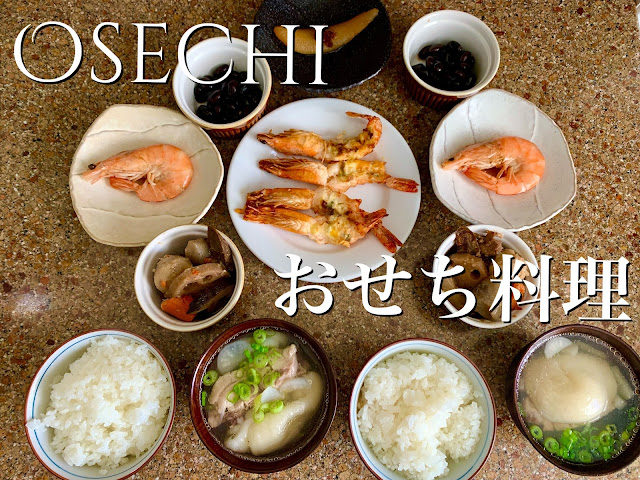New Year's holidays, which are called oshogatsu (お正月) in
Japanese, are the most important holidays for Japanese people. Today,
I'm going to share with you what I ate this New Year's holidays.
Traditional Japanese Food for New Year's Eve
It's a Japanese traditional that osoji (大掃除), big cleaning, is done in late December before the New Year comes. Indeed, my husband and I did osoji late December. The last meal before the New Year came was toshikoshi soba. It's a Japanese traditional to eat soba noodles, which are called toshikoshi soba (年越しそば, 年越し蕎麦).
Toshikoshi Soba (年越し蕎麦)
This time, my husband cooked soba noodles with prawn tempura. We purchased our favorite frozen prawn tempura at Costco.
Traditional Japanese Foods for New Year
Japanese New Year (Shogatsu) runs January 1 through January 7 (O-shogatsu, 大正月) or January 15 (Ko-shogatsu, 小正月). Specially, January 1 through January 3 is called sanganichi (三が日), and people visit shrines and meet families and relatives for the first time in the year and enjoy Japanese traditional New Year's foods.
Osechi (おせち料理)
Zoni (雑煮), Mochi Soup
During New Year's holiday, it's a Japanese traditional to eat
mochi. Specially, mochi soup which is called zoni (雑煮) or ozoni (お雑煮) is
commonly eaten in Japan during New Year's holiday.
Chikuzenni (筑前煮), Nishime (煮しめ)
I cooked this chikuzenni as our Osechi. I used some vegetable, konjack and chicken. If you are interested in how to cook chikuzenni, you can check out my previous entry, How to Cook Chikuzenni, Japanese Simmered Chicken and Vegetables.
Simmered Prawn, Ebi No Umani (海老のうま煮)
Prawn and shrimp are called Ebi in Japanese. Ebi symbolizes a wish for a long-life because of the appearance. When you are very old, you will probably have a bend waist.
Grilled Cheese Mayonnaise Prawns (海老マヨチーズ焼き)
Kazunoko (数の子, かずのこ), Herring Roe
Kazunoko (かずのこ) is herring roe. Kazu (数, かず) means number and Ko (子) means child, so Kazunoko symbolizes a lot of children and a large family.
Kuromame (黒豆), Sweetened Japanese Black Beans
Kuromame (黒豆) is black soy beans, and mame symbolizes working diligently and healthily.
It's not a traditional Japanese New Year's food, but my husband made a lot of taiyaki on New Year's Eve!
It's because tai (鯛) is a lucky fish! Tai (鯛, たい) means a red snapper, sea bream, in Japanese. People in Japan eat a broiled red snapper on happy events such as on a wedding day, baby's 100th day, New Year's day and etc. Auspicious is called medetai (めでたい) in Japanese. "Tai ha medetai (鯛はめでたい)" means tai is a good luck fish. That's why taiyaki is a kind of a good luck fish-shaped cake and can be eaten all year round. Because my husband cooked anko (あんこ), sweetened red bean paste, to eat with mochi for New Year's holidays, he also cooked taiyaki (たい焼き), Japanese fish-shaped cake filled with sweetened red bean pastes. You can also check my previous entries, How to Make Perfect Anko, Japanese Sweetened Red Bean Paste, and , How to Make Perfect Taiyaki, Japanese Fish-Shaped Cake.
Happy New Year's Holidays!
These are also my entries you might like.
♥Top 15 Popular Posts from Best Japanese Beauty Products
♥Top 15 Popular Posts from Best Japanese Beauty Products
♥5 Most Popular Japanese Sunscreens Can Be Purchased at Drugstores in Japan
♥16 Best Japanese Beauty Products I Purchased in Japan - Drugstore, Discount Store, Daiso and Amazon Japan
♥3 Best Japanese Sunscreens with SPF50+ PA++++
♥3 Best Japanese Sunscreens Won Beauty Award This Year
♥Top 3 Japanese Powder Sunscreens
♥3 Best Japanese Sunscreen Products to Try This Summer
♥3 Best Japanese Eye Creams Won Beauty Award This Year
♥3 Best Facial Sheet Masks Loved in Japan This Year
♥7 Most Popular Japanese Facial Cleansing Wipes for Removing Makeup
♥7 Best Japanese Beauty Products Hall of Fame
♥Top 5 Life-Changing Japanese Beauty Products
♥Top 5 Most Popular Japanese Charcoal Soap
♥5 Best Japanese Facial Lotion (Toner), Kesyou-sui
♥The Most Popular Facial Sheet Masks in Japan
♥4 Reasons Why I Love Kose Softymo Cleansing Oil
♥10 Best Japanese Beauty Products on Amazon Japan, You Can Also Purchase Them at Drugstores in Japan
My entries related to Best Japanese Beauty Products can be seen here.
My entries related to Japan can be seen here.
My entries related to beauty can be seen here.
My entries related to Japan Haul can be seen here.
You can find my beauty entries by categories from here.


.JPG)
.JPG)
.JPG)
.JPG)
.JPG)
.JPG)
.JPG)
No comments:
Post a Comment